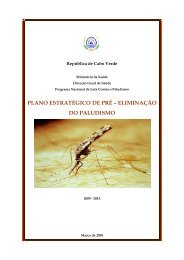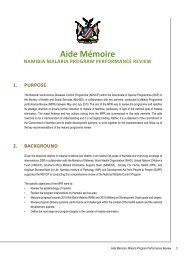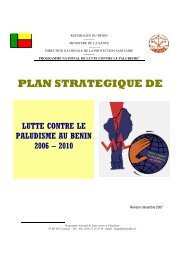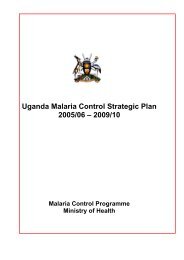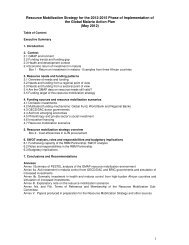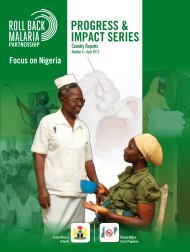Tanzania Malaria Programme Review 2010 - World Health ...
Tanzania Malaria Programme Review 2010 - World Health ...
Tanzania Malaria Programme Review 2010 - World Health ...
Create successful ePaper yourself
Turn your PDF publications into a flip-book with our unique Google optimized e-Paper software.
<strong>Tanzania</strong> <strong>Malaria</strong> <strong>Programme</strong> <strong>Review</strong> <strong>2010</strong><br />
ABBREVIATIONS<br />
<strong>Programme</strong> <strong>Review</strong> Proposal<br />
National <strong>Malaria</strong> Control Prigramme<br />
Ministry of <strong>Health</strong> and Social Welfare<br />
Dar es Salaam, <strong>Tanzania</strong><br />
May, <strong>2010</strong><br />
ACTs Artemesinin Combination Therapies<br />
ADDO Acredited Drug Dispensing Outlet<br />
1
DSS Demographic Surveillance Sites<br />
HMIS <strong>Health</strong> Management Information System<br />
IRS Indoor Residual Spraying<br />
ITNs Insecticide Treated Nets<br />
LLINs Long Lasting Insecticide Treated Nets<br />
MDGs Millennium Development Goals<br />
MPR <strong>Malaria</strong> <strong>Programme</strong> <strong>Review</strong><br />
MUHAS Muhimbili University of <strong>Health</strong> and Allied Sciences<br />
NMCP National <strong>Malaria</strong> Control <strong>Programme</strong><br />
THMIS <strong>Tanzania</strong> HIV and <strong>Malaria</strong> Indicator Survey<br />
WHO <strong>World</strong> <strong>Health</strong> Organization<br />
HIV Human Immunodeficiency Virus<br />
AIDS Acquired Immune Deficiency Syndrome<br />
DSS Demographic Surveillance Sites<br />
IPTp Intermittent Preventive Therapy in pregnancy<br />
SP Sulfadoxine-Pyrimethamine<br />
ALu Artemether-Lumefantrine<br />
PSI Population Services International<br />
ANC Antenatal Clinic<br />
NMMTSP National <strong>Malaria</strong> Mid-term Strategic Plan<br />
M&E Monitoring and Evaluation<br />
NPO National Professional Officer<br />
MUHAS Muhimbili University of <strong>Health</strong> and Allied Science<br />
UNICEF United Nations Children's Fund<br />
IHI Ifakara <strong>Health</strong> Institute<br />
PMI US-Presidential <strong>Malaria</strong> Initiative<br />
UDSM University of Dar es Salaam<br />
NEMC National Environmental Management Council<br />
MPR <strong>Malaria</strong> <strong>Programme</strong> <strong>Review</strong><br />
MSD Medical Store Department<br />
TFDA <strong>Tanzania</strong> Food and Drug Authority<br />
MOHSW Ministry of <strong>Health</strong> and Social welfare<br />
2
TABLE OF CONTENTS<br />
Abbreviations ..................................................................................................................... 1<br />
TABLE OF CONTENTS .................................................................................................... 4<br />
1.1 The <strong>Malaria</strong> burden ................................................................................................. 5<br />
1.2 Challenges in malaria control .................................................................................. 7<br />
2. REVIEW OBJECTIVES ............................................................................................... 10<br />
2.1 General objective .............................................................................................. 10<br />
2.2 Specific objectives ............................................................................................ 10<br />
4. REVIEW METHODOLOGY ......................................................................................... 13<br />
4.1. <strong>Review</strong> Tools ........................................................................................................ 16<br />
4.2. Data management ................................................................................................ 16<br />
5. EXPECTED MPR OUTPUTS ...................................................................................... 16<br />
Follow-Up of MPR Recommendations ..................................................................... 16<br />
6. MPR TIMELINE ........................................................................................................... 17<br />
7. REVIEW BUDGET ...................................................................................................... 19<br />
7. REFERENCES ............................................................................................................ 22<br />
4
1. INTRODUCTION<br />
1.1 The <strong>Malaria</strong> burden<br />
<strong>Malaria</strong> is the single most significant disease in <strong>Tanzania</strong> affecting the health and<br />
welfare of its 40 million inhabitants (projections from the population census of 2002).<br />
The population groups most vulnerable to malaria are children under five years and<br />
pregnant women.<br />
It is estimated that 90% of the population in <strong>Tanzania</strong> is at risk of malaria resulting<br />
into 11 million clinical malaria cases per annum (NMCP, 2008). There is increasing<br />
evidence in recent years that undoubtedly the scale-up of proven interventions are<br />
making an impact. The <strong>Tanzania</strong> HIV/AIDS and malaria indicator survey (THMIS)<br />
2007/08 demonstrate a significant decline in both infant and under-five mortality over<br />
the previous five years.<br />
Legend<br />
NN: Neonatal<br />
PNN:Perineonatal<br />
IMR: Infant Mortality Rate<br />
CM:Child mortality<br />
U5MR:Under-five mortality<br />
rate.<br />
Figure 1: Trends of Neonatal, Perinatal, Infant and Under five mortality in the last 10<br />
years, showing a steady and consistent decrease<br />
Studies carried out in the Demographic Surveillance Sites (DSS) have observed that<br />
malaria contributes to about 36% of all deaths in <strong>Tanzania</strong> in children under five<br />
years of age (IHRDC – DSS 2005), therefore it is a huge contributor to child<br />
mortality. The scaling up of malaria interventions country wide has significantly<br />
contributed to the reduction in infant and child mortality described above. For<br />
example the implementation of Intermittent Preventive Therapy in pregnancy (IPTp)<br />
since 2001, scaling up of ITNs for the most vulnerable groups since 2004 and the<br />
5
delivery of free Long Lasting Insecticidal (LLINs) to children under five years of age<br />
since 2009, change in malaria treatment policy from Sulfadoxine-Pyrimethamine<br />
(SP) to Artemether-Lumefantrine (ALu) in December 2006, and the introduction of<br />
Indoor Residual House-spraying (IRS) in epidemic prone areas and most recently<br />
the introduction of RDTs which is being phased into all the regions since 2009.<br />
The THMIS (2007/08) observed that the average malaria prevalence had declined<br />
from 20% during a similar survey in 2006 to 18%, with anaemia in under five<br />
children falling from 10% to 8% over the same period.<br />
In order to show the trends in malaria prevalence in the country; data is available<br />
from Rufiji and Ifakara Demographic Surveillance Sites where a signifiant decline<br />
has been observed since 2000. These two districts are highly endemic for malaria<br />
and are representative of typical intense malaria transmission areas. For example<br />
ifakara prevalence in 2000 was 35% and declined to 10% in 2008 which is a<br />
reduction of 60% in parasitaemia. This data is used as a proxy for the trends in<br />
malaria prevalence in the country as this is not available from previous demograhic<br />
health surveys.<br />
6
A number of institutions have carried out sub-national surveys in malaria control in<br />
recent years. These include;<br />
� Coverage of mosquito nets in selected districts by the National Institute for<br />
Medical Research (NIMR) – Feb – March 2008<br />
� Coverage of mosquito nets in selected districts by Population Services<br />
International (PSI) – March – May 2008<br />
� Coverage of mosquito nets, IPTp, the prevalence of parasitaemia and<br />
anaemia in selected districts by the NMCP – June 2008<br />
� The coverage of mosquito nets, IPTp, the prevalence of parasitaemia and<br />
anaemia in selected districts by the <strong>Tanzania</strong> National Voucher Scheme<br />
(TNVS) – July – Sept 2008<br />
The national representative data which are available through DHS and the <strong>Tanzania</strong><br />
HIV/AIDS and <strong>Malaria</strong> Indicator Survey (THMIS) are quoted by the MOHSW as the<br />
most representative data for malaria in <strong>Tanzania</strong><br />
1.2 Challenges in malaria control<br />
Source: THMIS 2007/08<br />
<strong>Malaria</strong> diagnosis<br />
<strong>Malaria</strong> treatment in <strong>Tanzania</strong> is mainly based on clinical judgement in the majority<br />
of health facilities, especially lower level facilities. Most of the health facilities lack<br />
laboratory diagnostic capacity for malaria and hence most of the reported malaria<br />
cases are clinically diagnosed. According to NMCP, up to early 2009, 83% of health<br />
7
facilities in <strong>Tanzania</strong> had no laboratory diagnostic capacity for malaria. In addition,<br />
there is a problem of inaccurate malaria microscopic diagnosis and hence<br />
misdiagnosis of patients and over use of ACT<br />
<strong>Malaria</strong> Treatment<br />
ACTs are available in the public health facilities and faith based organizations at no<br />
cost for children under the age 5 and pregnant women, and at a minimal cost for<br />
adults through cost sharing. ACTs are also available from the private health sector,<br />
but at prices that cannot be afforded by the majority of <strong>Tanzania</strong>ns.<br />
Other challenges with respect to treatment include improvement of access to ACTs<br />
in both the public and private sector, improving the awareness of people on the need<br />
for prompt treatment of malaria through ACTs, enhancement of the capacity of<br />
health workers on current malaria treatment, and inefficient flow of information from<br />
health facilities to NMCP related to ACT stock levels as well as ACT consumption.<br />
<strong>Malaria</strong> in pregnancy<br />
The challenges faced in control of malaria in pregnancy are firstly, to ensure<br />
availability of sufficient SP (Sulphadoxine-Pyremithamine) at health facility level.<br />
Secondly, advocacy needs to be enhanced to ensure timely attendance to ANC<br />
clinics. Thirdly, the quality of services at ANC clinics has to be improved through the<br />
provision of appropriate training for service providers.<br />
Use of ITNs/LLINs<br />
The distribution of ITNs has been carried out through a voucher system that target<br />
pregnant women and infants. The ITNs coverage to date is estimated to have<br />
reached 38% of households with at least one ITN, and 25% and 26% of children<br />
under 5 and pregnant women, respectively, using ITNs (2007-08, THMIS). Despite<br />
the intensive campaigns on the use of ITNs, the coverage indicators which have only<br />
been targeting children under five and pregnant women have not increased<br />
significantly. Re-treatment of the existing crop of conventional nets is also low.<br />
Indoor Residual House-spraying<br />
Indoor residual house-spraying (IRS) has been implemented in a high malaria<br />
prevalence region in North-western <strong>Tanzania</strong> with a high significant impact against<br />
8
the disease. The NMMTSP plans to expand this intervention to cover half of the<br />
country where prevalence is still high. The limiting factor is the availability of funds to<br />
cover the remaining 53 districts.<br />
Behavioural Change and communication (BCC)<br />
BCC campaigns need to be carried out in a more systematic and co-ordinated<br />
manner in order to ensure optimal utilization of resources and enhance their<br />
effectiveness. An integrated and comprehensive information and communication<br />
strategy for malaria should be developed taking into account current best practices.<br />
Thirdly, a large proportion of the rural population have limited access to information<br />
about the signs and symptoms of malaria, risk groups, need for immediate malaria<br />
treatment, and malaria prevention techniques. Thus there is an urgent need for the<br />
intensification of communication on malaria in the rural areas.<br />
Monitoring, evaluation, surveillance and operational research<br />
An M & E plan has been developed which includes operational research for malaria<br />
control. However there is a need to operationalize the plan with the NMCP partners.<br />
The main weaknesses in the process of monitoring, evaluation, and surveillance<br />
include: limited financial support from existing funding mechanisms; partners are not<br />
adequately coordinated to collect and report data for M&E purposes; lack of<br />
appropriate human resources with the required M & E skills; HMIS staffs at district<br />
level have not been trained in malaria M&E; limited capacity of M&E unit at NMCP;<br />
inefficient coordinating mechanisms amongst specific sub-recipients; weak M&E<br />
network to capture malaria related operational research; lack of appropriate<br />
dissemination plan; lack of systematic feedback to sub-reporting entities concerning<br />
data quality; and lack of timely malaria data.<br />
1.3 Rationale for the programme review<br />
Over the past ten years, malaria control interventions have been scaled-up at the<br />
national level, yet no comprehensive review of the <strong>Malaria</strong> <strong>Programme</strong> has been<br />
undertaken. The interventions include:<br />
� In the last quarter of 2006, <strong>Tanzania</strong> introduced a new antimalarial, ACT<br />
country wide.<br />
9
� IRS was introduced in some districts of Kagera region since 2007. By<br />
December 2009, the whole Kagera region was covered with IRS, including the<br />
islands in Lake Victoria which are part of Kagera region.<br />
� In late 2008, NMCP introduced the under-five catch-up campaign, whereby all<br />
children under five years of age were provided with an LLIN free to the end<br />
user.<br />
� Since 2006, larviciding has been implemented in some parts of Dar es<br />
Salaam region<br />
As <strong>Tanzania</strong> embarks on the ambitious goal of malaria elimination, it is now<br />
necessary to review progress and re-align the <strong>Programme</strong> as necessary to meet this<br />
goal<br />
2. REVIEW OBJECTIVES<br />
2.1 General objective<br />
To conduct a comprehensive <strong>Malaria</strong> <strong>Programme</strong> <strong>Review</strong> to identify achievements,<br />
constraints, and best practices to guide future malaria control policies for achieving<br />
malaria elimination in <strong>Tanzania</strong><br />
2.2 Specific objectives<br />
1. To review the malaria epidemiology in <strong>Tanzania</strong><br />
2. To review the NMCP programming framework within the context of the health<br />
system (programme structure, management and operation)<br />
3. To assess the progress towards achievement of national, regional and global<br />
targets<br />
10
4. To conduct desk review of current status on malaria interventions coverage<br />
since 2000<br />
5. To conduct desk review on impact of malaria intervention scale-up in<br />
<strong>Tanzania</strong> since 2000<br />
6. To identify gaps and priority areas for guiding the national, regional, district,<br />
facility-level, and community field visits<br />
7. To identify the spectrum of factors that facilitated or hindered the (service)<br />
delivery, use and impact of interventions at all levels<br />
8. To define the next steps for improving programme performance or redefining<br />
the strategic direction and focus including revisiting the polices and strategic<br />
plans<br />
9. To disseminate the MPR outputs and translate findings for realigning malaria<br />
control strategy in <strong>Tanzania</strong><br />
11
3. REVIEW PROCESS TASK MANAGEMENT AND<br />
COORDINATION<br />
The decision was sought to conduct this review from the MOHSW. The NMCP M&E<br />
Technical Working Group has been appointed to move the MPR process forward.<br />
The Working Group has obtained consensus from the Ministry of <strong>Health</strong> and Social<br />
Welfare, multiple stakeholders, and donors.<br />
� Appointment of review coordinator and review secretariat<br />
The review coordinator, Ms. Jubilate Minja has been selected by the National<br />
<strong>Malaria</strong> Control <strong>Programme</strong> Manager. The NMCP has opted to appoint the existing<br />
<strong>Malaria</strong> M&E Technical Working Group to assume the duties of the MPR secretariat<br />
� The Internal review team<br />
Several working groups/committees exist within the NMCP: malaria vector control,<br />
BCC working group, case management and M&E. Members from these working<br />
groups and representatives from prevention department of the MOHSW will<br />
constitute the internal review team, plus subject institutions and partners in malaria<br />
control in the country, such as WHO-NPO, MUHAS (senior experts), IHI, NIMR, PMI,<br />
UNICEF, Global Fund, <strong>World</strong> Bank, UDSM, NEMC and Clinton Foundation.<br />
� The external review team<br />
This will consist of invited experts from WHO, international consultant recommended<br />
by the WHO and selected NMCP managers invited from experienced countries.<br />
12
4. REVIEW METHODOLOGY<br />
The MPR process will be manly a desk and field review of all technical and<br />
management areas of malaria control in <strong>Tanzania</strong>. The selected review teams will<br />
cover the following technical areas - case management and laboratory, vector<br />
control and Entomology, Pharmacology, epidemiology, advocacy and monitoring and<br />
evaluation.<br />
The program review will be conducted in four phases; Preparatory and Planning,<br />
Internal thematic desk reviews, Joint programme field reviews and lastly report<br />
writing, dissemination of results, implementation of recommendations<br />
Phase I: Preparatory and planning<br />
This proposal has been prepared in collaboration with malaria control partners and<br />
stakeholders. <strong>Review</strong> secretariat will be responsible for logistics, secretarial,<br />
communication and support. TORs for recruiting internal and external consultants<br />
will be prepared.<br />
Eight (8) regions and one district from each region representative of the country have<br />
been chosen. These are Magu, Muleba, Kasulu, Lushoto, Dodoma, Rufiji, Tunduru<br />
and Mtwara. There will be coordination meetings for consultation throughout the<br />
MPR. Field visits including all logistics including; transport, accommodation and<br />
support for local teams will be managed by the review secretariat with a designated<br />
focal point assigned to coordinate the task.<br />
Phase II: Internal thematic desk review<br />
A review task team (with a minimum of 10 people) will be formed, consisting of the<br />
coordinator, the review secretariat, members from the technical working groups and<br />
a senior independent internal expert.<br />
Eight thematic areas will be reviewed by a subject internal review team. These are:<br />
o <strong>Programme</strong> management<br />
o Case management and diagnosis<br />
13
o <strong>Malaria</strong> prevention and treatment in pregnancy<br />
o <strong>Malaria</strong> vector control<br />
o Advocacy, IEC and BCC<br />
o M&E, epidemiology, surveillance and operational research<br />
o Epidemic and emergency preparedness and response<br />
o <strong>Malaria</strong> commodities procurement and supplies<br />
This phase will involve desk review by thematic areas based on programme data,<br />
reports, published/grey literature, plans, proposals and so forth.<br />
Each thematic group will have a consultant who will be responsible for reporting to<br />
the secretariat and writing a final thematic review report. The team will amend the<br />
checklist to suit the respective context.<br />
Phase III: Joint programme field reviews<br />
In this phase III, field visits in 10 selected regions will be conducted. Members from<br />
each internal team will form part of the consolidated field team, which will constitute<br />
of both the internal and external members. Before the visit, briefing will be done to<br />
familiarise teams with the whole MPR process, field data collection tools and<br />
required reports from the field visits as well as final required reports (including press<br />
release, press conference, aide-memoire, media events, stakeholder workshops,<br />
etc)<br />
The 10 selected regions will be divided in 3 ‘hypothetical’ zones, depending on the<br />
geography of the country; therefore, three field teams will be formed. Three of the<br />
teams will visit 3 regions each, while one remaining team will visit four regions.<br />
Each group will be responsible for reporting to the secretariat and writing a<br />
respective field report.<br />
14
LEVEL INTERVIEWS/MEETINGS<br />
NATIONAL Minister for <strong>Health</strong> and Social Welfare, Permanent Secretary, Chief<br />
Medical Officer, All Directors and Assistant Directors, Commissioner of<br />
Social Welfare, Vector-borne diseases officer, Environmental <strong>Health</strong><br />
unit, NMCP manager, Heads of cells,<br />
DG of MSD, NIMR, TFDA, NEMC, Minister/representative from<br />
Ministry of Water and Irrigation; Minister/representative of Lands,<br />
Houses and Development of Human Settlement, WR, country<br />
representative UNICEF, PMI, and private sector representatives<br />
REGIONAL RMO and RHMT, HIMS, RMFP, Heads of related Departments,<br />
Environmental <strong>Health</strong>, some NGOs at regional level.<br />
DISTRICT DMO and CHMT, HIMS, DMFP, Heads of related Departments,<br />
Environmental <strong>Health</strong>, some NGOs.<br />
HEALTH<br />
FACILITIES<br />
In-charge of <strong>Health</strong> facilities, heads of departments, HIMS, Nurses,<br />
Environmental <strong>Health</strong> Practitioners;<br />
COMMUNITY 12 people from the community per FGD, 2 FGD per district.<br />
Phase IV:<br />
In this phase, teams will finalise their reports and prepare a single MPR report. The<br />
aide memoire will also be prepared. Depending on the recommendations given,<br />
strategic plan, annual operational plans, guidelines and project proposals will be<br />
updated; a re-design of programme will be done if required. Articles for publication in<br />
peer reviewed journal will be prepared.<br />
The results will be disseminated to the MOHSW administration, stakeholders and<br />
publications will be done.<br />
15
4.1. <strong>Review</strong> Tools<br />
WHO review check lists and tools will be adapted to address the <strong>Tanzania</strong>n context.<br />
Each internal team will build consensus on the tools and the final tools will be pretested<br />
in one of the districts.<br />
4.2. Data management<br />
The data collected will be captured in excel spreadsheets and tables and will be<br />
analysed with the assistance of biostatisticians. Both qualitative and quantitative<br />
statistics will be used to analyse the data.<br />
5. EXPECTED MPR OUTPUTS<br />
The MPR expected outputs of are:<br />
� <strong>Programme</strong> thematic areas and sub-national reports of the review<br />
� <strong>Programme</strong> <strong>Review</strong> Aide Memoire<br />
� <strong>Programme</strong> <strong>Review</strong> Report<br />
� Updated Medium Term Strategic Plan (2008-13), <strong>Malaria</strong> M&E Plan<br />
� Peer-reviewed journal publications of program review articles<br />
� Feedback to the <strong>Malaria</strong> Technical Working Groups and member of <strong>Malaria</strong><br />
advocacy Committee<br />
The dissemination of the review report will include all partners and stakeholders who<br />
will be engaged in updating the strategic plans for malaria program.<br />
Follow-Up of MPR Recommendations<br />
The NMCP in collaboration with partners will implement the recommendations from<br />
the programme review.<br />
16
6. MPR TIMELINE<br />
The MPR is expected to run from May <strong>2010</strong> to September 2011 detailed timeline is<br />
shown in Gantt chart below:<br />
Phase<br />
Phase 1.<br />
Planning<br />
the malaria<br />
programme<br />
review<br />
<strong>Review</strong> time line (Gantt chart)<br />
<strong>2010</strong> 2011<br />
Steps M A M J J A S O N D J F M A M J J A S O<br />
Step 1. Identify the<br />
need for a review<br />
Step 2. Build consensus<br />
to conduct a review<br />
with NMCP, MOHSW,<br />
partners and<br />
stakeholders<br />
Step 3. Appoint a<br />
review coordinator and<br />
establish internal<br />
review secretariat and<br />
internal review task<br />
team<br />
Step 4. Define the<br />
objectives and outputs<br />
of the review<br />
Step 5. Develop review<br />
proposal with budget<br />
and identify funding<br />
sources.<br />
Step 6. Identify and<br />
agree on terms of<br />
reference for internal<br />
and external review<br />
teams.<br />
Step 7. Make official<br />
request to WHO for<br />
technical support.<br />
Step 8. Select central,<br />
regional and district<br />
field sites for<br />
interviews and<br />
observations.<br />
Step 9. Plan<br />
administration and<br />
logistics.<br />
Step.10 Develop review<br />
checklist of activities<br />
Phase Steps M A M J J A S O N D J F M A M J J A S O<br />
17
Phase.2<br />
Internal<br />
thematic<br />
desk review<br />
Phase Steps<br />
Phase.3.<br />
Joint<br />
programme<br />
field review<br />
Step 1. Assemble<br />
information from<br />
available documents<br />
and reports<br />
Step 2. Conduct a<br />
technical desk review.<br />
Step 3. Compile the<br />
thematic desk review<br />
report.<br />
Step 4. Select and<br />
adapt data collection<br />
tools for field review.<br />
Step 5. Meet with RMOs<br />
and DMOs and<br />
familiarise with them<br />
the MPR. Give them<br />
the profile templates<br />
Step 1. Briefing of and<br />
team-building between<br />
internal and external<br />
review teams<br />
Step 2. Consensusbuilding<br />
on findings of<br />
thematic internal desk<br />
review<br />
Step 3. Familiarization<br />
with data collection<br />
tools for field visits<br />
Step 4. Briefing and<br />
formation of field<br />
teams for field review<br />
Step 5. Central visits to<br />
national institutions<br />
and organizations<br />
Step 6. Regional, state,<br />
district and community<br />
field visits to malaria<br />
service delivery points<br />
Step 7. Sharing of<br />
reports and<br />
presentations from<br />
field review and<br />
consensus on key<br />
findings.<br />
Step 8. Preparation of<br />
field reports<br />
Step 9. Preparation of<br />
executive summary,<br />
aide-memoire and slide<br />
presentation of key<br />
findings and<br />
recommendations.<br />
Share aide memoir<br />
with partners before<br />
goes to CMO for signing<br />
Phase Steps<br />
M A M J J A S O N D J F M A M J J A S O<br />
M A M J J A S O N D J F M A M J J A S O<br />
18
Step 10. Preparation of<br />
Summary reports of<br />
Abuja targets<br />
Step 11. Presentation<br />
of review findings and<br />
recommendations to<br />
MOHSW<br />
Step 12. Presentation<br />
of review findings and<br />
recommendations to<br />
partners<br />
Step 13. Completion of<br />
final of review report<br />
Step 14. Prepare<br />
Articles for publication<br />
in peer reviewed<br />
Journals<br />
Phase Steps M A M J J A S O N D J F M A M J J A S<br />
Phase 4.<br />
Final report<br />
and followup<br />
on<br />
Recommend<br />
ations<br />
7. BUDGET<br />
Step 1. Finalize and<br />
publish report<br />
Step 2: Printing the<br />
report 2000 copies<br />
Step 3. Disseminate<br />
and distribute report to<br />
regions, stakeholders,<br />
press release<br />
Step 4. Implement<br />
recommendations<br />
through: updating<br />
strategic plan,<br />
guidelines,<br />
implementation plan<br />
and proposals.<br />
Step 5. Monitor<br />
implementation of the<br />
recommendations.<br />
Phase Steps Item Total Costs<br />
Phase 1. Planning Step 1: Identify the need 0<br />
the malaria for a review<br />
-<br />
programme review<br />
19
Phase.2 Internal<br />
thematic desk<br />
review<br />
Step 2: Build consensus to<br />
conduct a review with<br />
partners and stakeholders<br />
Step 3: Appoint a review<br />
coordinator and establish<br />
internal review secretariat<br />
and internal review task<br />
team<br />
Step 4: Define the<br />
objectives and outputs of<br />
the review<br />
Step 6: Make official<br />
request to WHO for<br />
technical support.<br />
Orientation of MPR to<br />
Ministriy's officials<br />
Training to NMCP staffs on<br />
MPR<br />
Orientation of MPR to<br />
partners<br />
Step 7: Select central,<br />
provincial and district field<br />
sites for interviews and<br />
observations.<br />
Step 5. Identify and agree<br />
on terms of reference for<br />
internal and external<br />
review teams.<br />
Step 8: Administrative plan<br />
and logistics.<br />
Step 9: Develop review<br />
checklist of activities<br />
Step 10: Develop review<br />
proposal with budget and<br />
identify funding sources.<br />
Step 1. Assemble<br />
information from available<br />
documents and reports<br />
Step 2: Conduct a<br />
technical desk review.<br />
20<br />
1 meeting<br />
meeting of review<br />
team<br />
meeting/bworkshop<br />
0<br />
meeting<br />
17,272,000<br />
-<br />
4,494,000<br />
-<br />
3,942,999<br />
workshop 16, 443,000<br />
0<br />
meeting<br />
meetings<br />
Photocopying<br />
Meeting of subgroups<br />
and local<br />
consultants support<br />
17,272,000<br />
-<br />
569,974<br />
122,837,354<br />
16,556,425<br />
1,709,922<br />
2,279,896<br />
35,900,000
Phase 3. Joint<br />
programme field<br />
review<br />
Step 3: Compile the<br />
thematic<br />
report.<br />
desk review<br />
Step 4: Select and adapt<br />
data collection tools for<br />
field review.<br />
Step 5. Training to zonal<br />
teams<br />
Step 1: Briefing of and<br />
team-building between<br />
internal and external<br />
review teams<br />
Step 2: Consensusbuilding<br />
on findings of<br />
thematic<br />
review<br />
internal desk<br />
Step 3: Familiarization<br />
with data collection tools<br />
for field visits<br />
Step 4: Briefing and<br />
formation of field teams for<br />
field review<br />
Step 5: Central visits to<br />
national institutions and<br />
organizations<br />
Step 6: Provincial, state,<br />
district and community<br />
field visits to malaria<br />
service delivery points,<br />
and prepare zonal reports<br />
Step 7. Sharing of reports<br />
and presentations from<br />
field review and consensus<br />
on key findings, and<br />
compile field reports<br />
Step 9. Preparation of<br />
executive summary, aidememoire<br />
and slide<br />
presentation of key<br />
findings and<br />
recommendations<br />
Step 10. Presentation of<br />
review findings and<br />
recommendations<br />
Step 11. Completion of<br />
final draft of review report<br />
21<br />
Meeting of subgroups<br />
and local<br />
consultants' support<br />
Meeting of subgroups<br />
and local<br />
consultants support<br />
training<br />
Internal and<br />
External consultants<br />
travel and per diem<br />
Meeting of subgroups<br />
and local<br />
consultants support<br />
Meeting of subgroups<br />
and local<br />
consultants support<br />
Meeting<br />
Travel and per diem<br />
for internal and<br />
external consultants<br />
39,531,400<br />
2,279,896<br />
53,446,000<br />
8,988,000<br />
4,494,000<br />
38,755,500<br />
2,279,896<br />
113816000<br />
Meeting 18986000<br />
Workshop- 9119583.667<br />
meeting 4494000<br />
workshop 35446000
Phase 4. Final<br />
report and followup<br />
on<br />
Recommendations<br />
Grand total<br />
7. REFERENCES<br />
Step 1. Finalize and<br />
publish report<br />
Step 2. Disseminate report<br />
to government officials<br />
Disseminate report to<br />
implementing all partners<br />
Step 3. Implement<br />
recommendations as part<br />
of updating policies,<br />
guidelines and plans.<br />
Step 4. Monitor<br />
implementation of the<br />
recommendations.<br />
Step 6. Update malaria<br />
policies and strategic and<br />
annual operational plans,<br />
and redesign programme,<br />
if necessary.<br />
22<br />
Formatting and<br />
publishing report<br />
9119583.667<br />
7124000<br />
10,752, 000<br />
meetings 20800000<br />
0 0<br />
Meeting of subgroups<br />
and<br />
stakeholder<br />
meetings<br />
17, 436,750<br />
591,514,429<br />
1. Demographic Surveillance Sites (DSS 2005) report<br />
2. National <strong>Malaria</strong> Medium Term Strategic Plan 2008-2013<br />
3. NIMR, (2008) Coverage of mosquito nets in selected districts by the National<br />
Institute for Medical Research (unpublished)<br />
4. NMCP (2008) Coverage of mosquito nets, IPTp, the prevalence of<br />
parasitaemia and anaemia in selected districts.<br />
5. THMIS 2007/08




